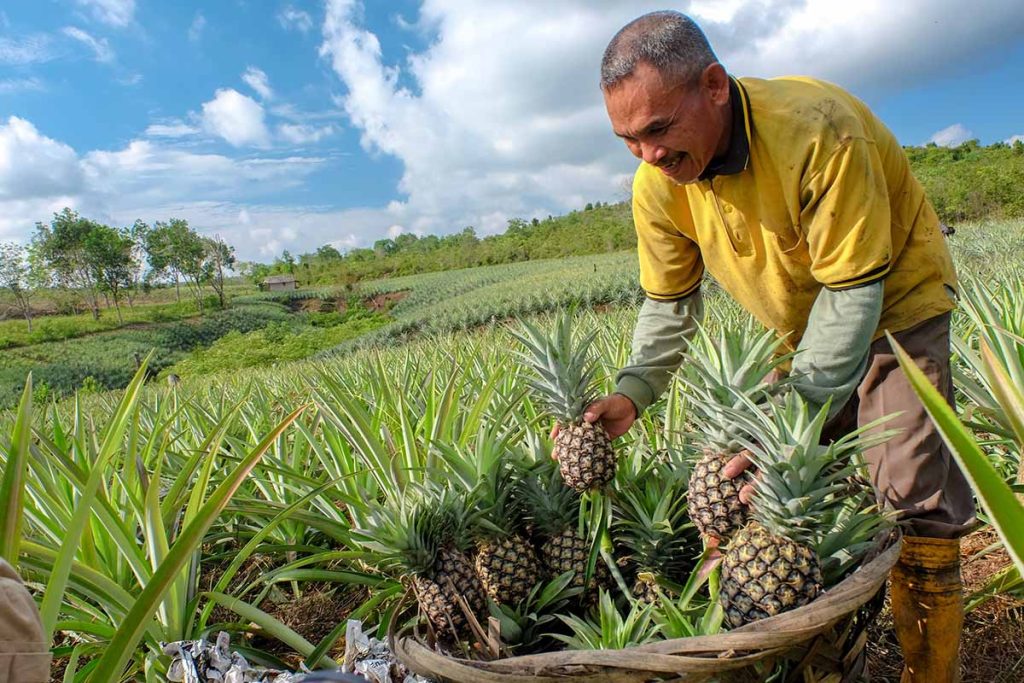for Palm Oil
Most of the treated trees show good sign of recovery, disappearing of mycelium and decay of Ganoderma fruiting body, new leaves are growing, trees that were not bearing fruits started to bear fruits again.
There are testimonials from palm oil owners who tested Farmour on their entire 1-acre planation of 50-60 trees, with many trees having Ganoderma and/or BSR issue. After 2-3 months, they found that many trees started growing leaves, and bearing fruits. Some of the trees produced fruits that are fuller and heavier, and hence the yield had improved from earlier months.

Typically, trees surrounding the Ganoderma affected trees may also have some level of Ganoderma disease although not visible to the naked eye. Through applying as preventive measure by using 1-2 treatments, “unnoticed” Ganoderma fungal in these surrounding trees can be controlled resulting in the overall improvement of the yield.
Some plantation owner is using this as a yield improvement measure. Please refer to attachment for more details.
treat palm oil tree with Ganoderma Successful New leaf growing. 棕榈油树灵芝问题.成功. 新叶
After treatment 2 times with Farmour premium. Palm oil tree with Ganoderma starts to fruit.
Trial on paddy, pineapple..
For pineapple, we supported a consultant in Terengganu to test on Heart Rot disease菠萝心腐病 in June 2023. We understand that the consultant did a few different tests by themselves and gave positive feedback to us about 12 months later. Based on that success, we decided to go further and managed to secure a pineapple plantation company to conduct a proper test with us in Ipoh, started in Aug 2024.
For paddy, we understand there is a disease that is challenging, namely Bacterial Panicle Blight on paddy (BPB) 水稻细菌性穗枯病. We tested our material around Nov of 2022. The paddy showed better yield, about 10% increase in raw weight, and healthier. However, we will need a much larger scale test to convince the Government. We are looking for a partner to run this large-scale test with us.
Anti-phytopathogenic Fungus Test
Shengyang Agricultural University
| Pathogenic Fungi | Anti-fungal Rate (%) |
|---|---|
| Thanatephorus cucumeris | 83.84 |
| Alternaria alternata | 81.12 |
| Pathogenic fungi of tobacco root rot | 68.25 |
| Phytophthora parasitica var. nicotianae | 66.08 |
| Magnaporthe oryzae | 59.38 |
| Ustilaginoidea virens | 56.28 |
| Fusarium graminearum | 89.50 |
| Rhizoctonia solani | 88.50 |
| Rhizoctonia solani kuha | 87.20 |
| Exserohilum turcicum | 80.67 |
| Bipolaris maydis | 72.80 |
| Pathogenic fungi for gibberella ear rot of maize | 58.42 |
| Cercospora sorghi | 51.30 |
| Pathogenic fungi of soybean root rot | 75.00 |
| Phytophthora sojae | 63.30 |
| Rhizoctonia solani of potato | 85.84 |
| Alternaria solani | 75.99 |
| Phytophthora infestans | 70.00 |
| Fusarium oxysporum | 78.75 |
| Pythium aphanidermatum | 66.66 |
| Fusarium oxysporum sp. cucumerium Owen | 62.27 |
| Botryosphaeria dothidea | 55.84 |
| Thanatephorus cucumeris of potato | 66.53 |
| Phytophthora infestans of celery | 79.07 |
| Phomopsis vexans (Sacc. et Syd.) Harter | 59.18 |
| Colletotrichum capsici | 42.23 |
Farmour 农护甲 抗细菌 抗真菌 预防病毒 治疗病毒 抗霉 贮藏力 Anti-bacteria, anti-fungal, prevent virus +6019 304 5689